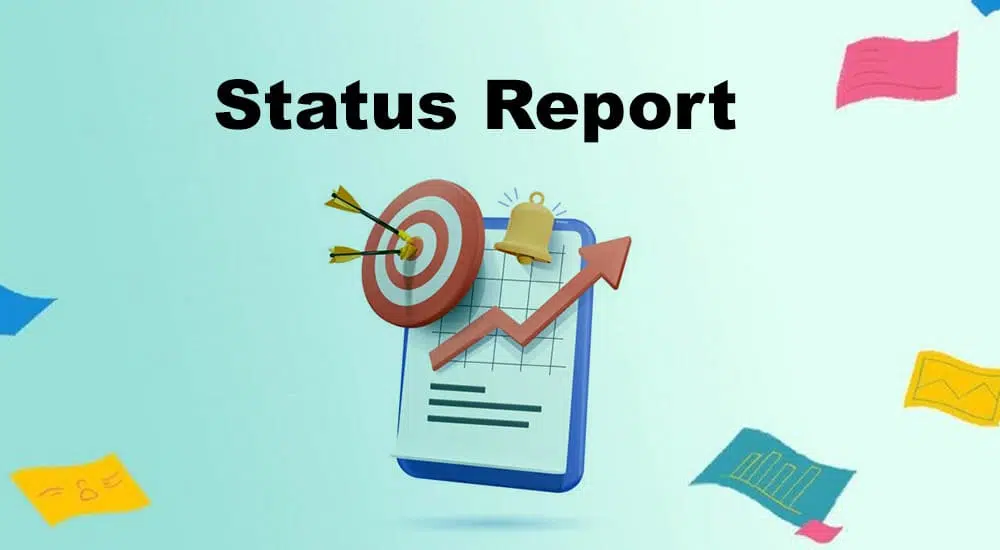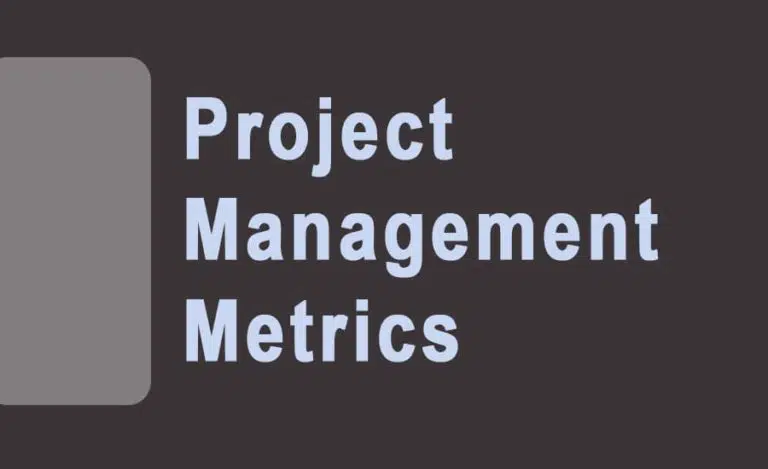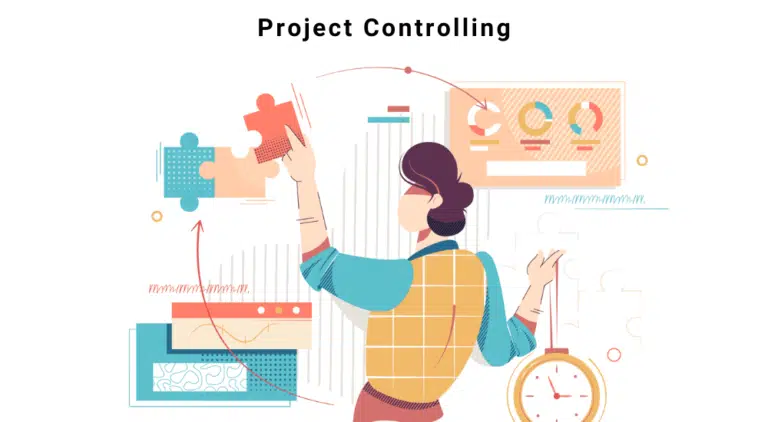A project status report is a project management document that details the status of a project. It’s a project reporting tool that outlines the project’s health and provides vital data to project stakeholders such as clients, sponsors, and team members.
Project managers communicate the project status to management and key stakeholders through a project status report. A status report is a part of project performance reports.
A status report shows the complete project information in its current state. These reports are prepared throughout the project life cycle to help keep the project on track and stakeholders informed.
A project’s status report can include the following:
- Completed work
- Achieve milestones
- Spent cost
- Budget and timeline summary
- A list of things to do
- Any hazards
- Risk responses
- New identified risks
The significance of the project status report extends beyond a communication channel. It offers a written account of the project’s past and provides you with previous data so you can plan for potential future bottlenecks.
The Purposes of Project Status Reports
Project status reports serve the following purposes:
- Help the project team maintain a record of expenses, tasks, deadlines, etc.
- Boost internal communication within the business
- Reduce communication complexity
- Deliver important messages to project stakeholders
- Boost project support within the business
- Help locate problems and dangers to enable immediate route modification
- Mark the progress
Types of Project Status Reports
Project status reports can be weekly, bi-monthly or monthly. You can share the weekly report with the project team to stay updated and the bimonthly or monthly report with other stakeholders, such as upper management and the client.
You can use Google Sheets, Microsoft Project, Microsoft Word, Microsoft Excel, or any other tool to prepare the status report.
The Weekly Status Reports
The project manager updates this report daily to keep track of the project.
A few recipients of this report are the following:
- Project team members
- Top management
- Resource managers
- Project sponsor
The weekly project status report has more information than other reports. It covers all essential details so that stakeholders directly involved with the project get a complete picture of the project’s status, including hazards, milestones, spent cost, and elapsed duration, among others.
The Monthly Status Reports
Monthly status reports are usually for higher-level management and sponsors so they know what is happening with the project.
These stakeholders require a comprehensive overview of the project’s development. They are interested in tracking budget, spending, deliverable quality, hazards, obstacles, etc.
However, if the project manager faces any issues, they should not wait for the monthly report. Instead, inform management immediately to get management buy-in when issues occur.
How to Track the Project Using Project Status Report
The following can help ensure the project stays on the right track:
Create a Project Outline or Plan: Make a preliminary blueprint of your project from beginning to end, including all necessary elements, resources, and duration, before formally starting the project.
Establish Specific Objectives: Decide what you want to achieve with this project, such as launching a new marketing campaign or a new product.
Identify Critical Milestones: Identify important project milestones to ensure they are achieved on time and meet all project objectives.
Establish Deadlines: Ensure that you and your team know all the deadlines.
Verify the Project Status: Regularly verify the status of your project as it gets underway by comparing it to the anticipated timeframe that should be found in your project plan.
Challenges with Project Status Reports
Reporting project status is challenging. Therefore, keep the following points in mind while preparing a project status report:
- Scheduling, estimating, and forecasting costs are uncertain, and project managers have limited information on these parts of the status report. Risks can be identified but not quantified accurately.
- Simplifying the project is not always the right strategy. There is a higher likelihood of missing significant details.
- Ensure the data are valid and correct. Incorrect data can lead to false reporting and affect the project objective.
Elements of Project Status Reports
A project status report can have many elements depending on the project requirements. Some common elements for status reports are:
- General project information, such as the project’s name, code, etc.
- Names of the project manager and any important team members
- Date of the status report, including the cadence (e.g., weekly, bi-weekly, or monthly)
- Project parameter update, including whether the project remained within its stated parameters at this time
- Current budget status, including whether it is on track, off track, or exceeded
- Quality issues that the project is facing
The stakeholders’ preferences affect the content of the status report. However, the components mentioned above are common to all status reports.
How to Create a Project Status Report
A robust project status report ensures nothing slips through the cracks. The following items can help you create a strong report.
Collect Information for Your Report: Before beginning your report, you must gather information from all sources. You can gather information at the departmental or divisional levels, depending on the organizational structure of your project.
Determine Your Target Audience: Whom are you trying to reach? What information is most important to them? Knowing your target audience can help you communicate essential information.
For example, the CEO, investors, and senior executives are more concerned with the broad picture. Most essential stakeholders will just skim status reports for the information they need since they may not have time to review lengthy reports.
To that end:
- Increase your focus on the crucial details
- Summarize the report’s components
- Use visual aids as much as possible
Be careful to highlight the main points in the executive summary. Also, emphasize essential details early in each report area.
Figure out what appeals to your stakeholders and customize the report accordingly.
Utilize Project Status Report Templates: It might be tricky to start from scratch when writing a project status report. However, without templates, you risk making mistakes or overlooking crucial information.
Utilizing templates enhances productivity, decreases mistakes, and saves time.
Write Your First Draft: You now have the data and report template. Outline the essential parts of your project first.
Make Your Executive Summary Compelling: The executive summary is your project report’s first and most essential element. Clients, investors, and management will see this part first.
It should catch the curiosity of your readers and drive them to learn more about the subject. Your readers should be able to learn everything they need to about your project with a single glance.
Remember to emphasize important details:
- Project objectives and primary outputs
- Whether you are making progress and possible pitfalls
- The state of your project as a whole
- Defining moments
- Irregular project hazards
- Information about the project’s finances
Write Your Project Status: You’ll need to supply detailed information on all project sections, such as
- Project deliverables and tasks
- Resources
- Targets and a timetable
- Significant changes
- Budgets and funding
- Team roles and effectiveness
- Management of risk (bottlenecks, risk, and contingency plans)
The status report needs to provide an overview of the full undertaking. Therefore, you should provide links to publications or resources for stakeholders who want more detailed and/or specific information.
Highlight Existing and Future Bottlenecks: Despite how diligently you prepare and carry out your project management strategy, obstacles may still arise.
Both internal and external influences can cause these obstacles. Obstacles include:
- Project risks, including rising import taxes or a natural disaster
- Unexpected budgetary growth or insufficient resources
- Lack of cooperation and communication among the team
- Unexpected delays
After identifying obstacles, inform stakeholders so you can take the initiative to clear obstacles.
Utilize Visual Aids: When drafting stunning project reports, visual aids are essential. They make it easier for project managers to discuss data points or explain complex information.
It also makes the report more attractive. When feasible, try to depict facts rather than write lengthy paragraphs.
The following elements help create a visually appealing project status report:
- Pie charts
- Bar graphs
- Other relevant graphs
- Brain mapping
- Videos and images
Take Design into Account: Your report should be easy to read, well-put-together, and aesthetically appealing. To increase visual appeal, use a consistent style, branding, palette, font, color, and design element across your report.
Point Out the Next Course of Action: The next stages will vary depending on your project and phase. Though, it’s a good idea to inform everyone of the project’s direction.
If stakeholders are aware of the subsequent phases, they will know what needs to be done when the project faces obstacles.
Review and Edit Status Report: Read your project report carefully and edit it for correctness, readability, etc.
Check your report carefully for grammatical, punctuation, and spelling errors. Additionally, ensure your report includes all necessary components of a project status report.
Delete the information that does not add value to the status report.
Best Practices for Creating Project Status Reports
Consider the following points when developing a sound project status report:
- Write the initial draft – then correct it
- If necessary, edit your status report
- Request input on presenting the project status in the best possible way
- Use consistency throughout all project status reports
- Report on the indicators that key stakeholders are looking for
- When it’s possible, use visuals like charts and graphics
- Avoid adding a lot of unnecessary details
- Ensure that everyone has access to the status report
Case Study of Project Status Report
Let’s consider a case study to understand how to create a project status report.
Report name: eCommerce Site Launch
Project status: On track
Summary
There has been significant progress this week. The project is still in the collecting requirement process. Development and design teams are on standby to get ready and start once we give go ahead. The eCommerce site will list all FMCG products.
Concept
- The planning team meets and discusses the overall topic
- A few ideas will be finalized and selected on Friday
- Brief or understanding is due to the Content team by the following Thursday
Development and Content
- The solution architect team is ready to present the infrastructure architecture that would integrate for launching the eCommerce portal.
- The content team is ready to start writing marketing content to attract traffic as soon as the idea is finalized.
- Gathered relevant company information should be included and used to market a better eCommerce site
Design
- Infra design reviewed by the senior members to validate it
- A new template to showcase the technical specifications of cloud infrastructure will be created by Tuesday
Additional Notes or Highlights
- Ramesh is out of the office all next week, so your next point of contact would be Joy
- Thank you to John for curating a detailed list of topics that would be used for prioritizing the following tasks
Issues/Challenges
- The portal launch deadline is too tight, and the minimum viable product’s first version needs to be launched as soon as possible. We must have the schedule planned within our project management tool to keep everyone organized and on track.
Project Status Report Example
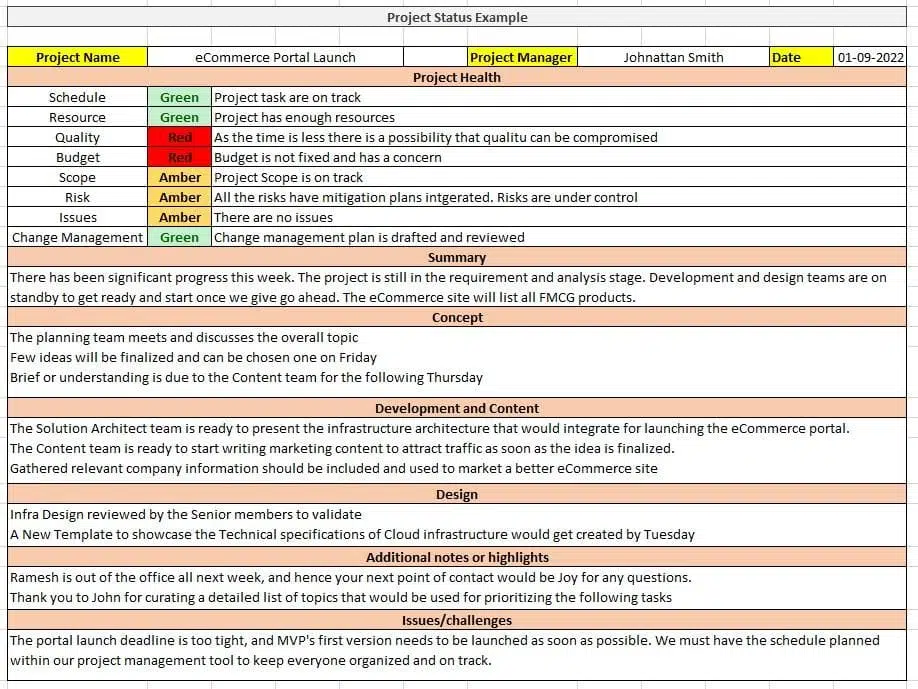
Project Status Report Template
The following are a few templates for providing a project status report. You can select one and customize them as per your requirement.
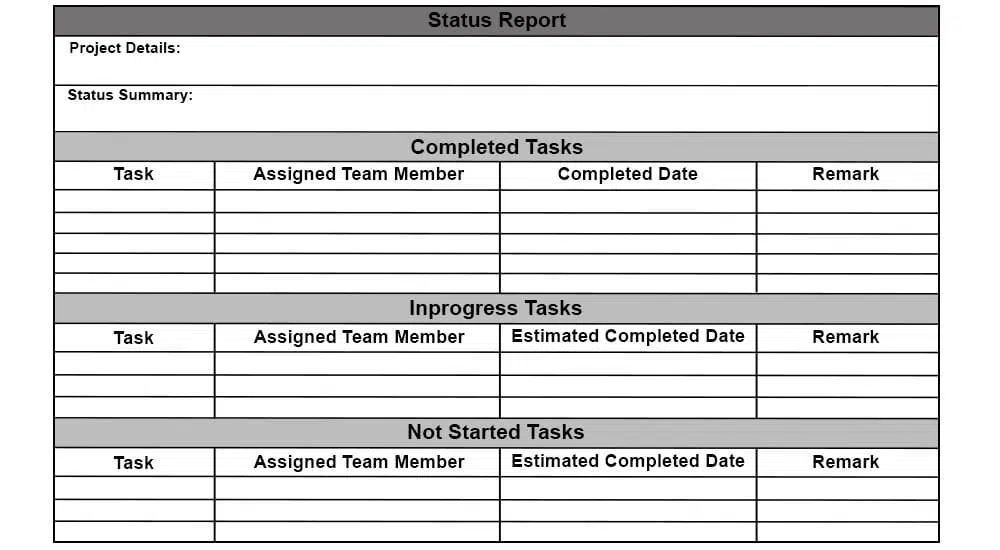
Project Information: Include general information about the project. The template would have information like project details and reporting period.
Project Status Summary: Includes the information that can be shared with project stakeholders and team members about project progress, key accomplishments, completed work, planned work, project milestones, project deliverables, action items, etc.
Project Health: Includes information about project stakeholders and team members, the current status of the project, and how it compares to the project plan.
Risk Management Overview: Includes project risks, issues, and roadblocks
Conclusions / Recommendations: Includes risk management, resource management, or project scheduling concerns/recommendations.
Other Project Status Report Templates
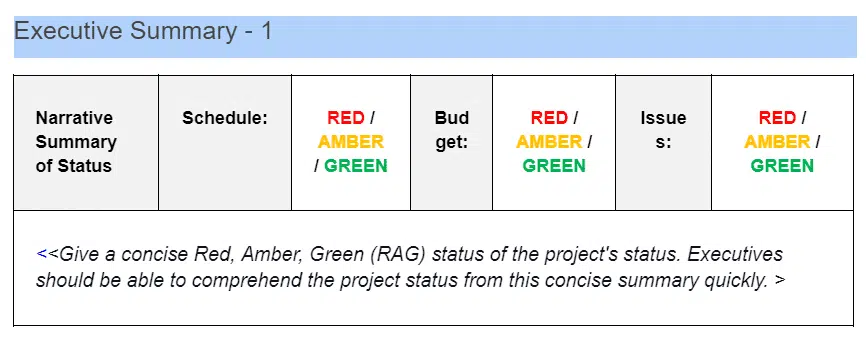
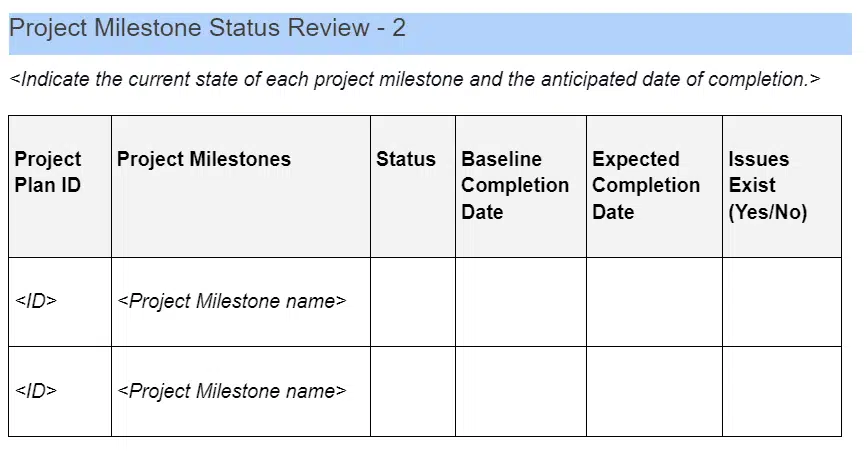
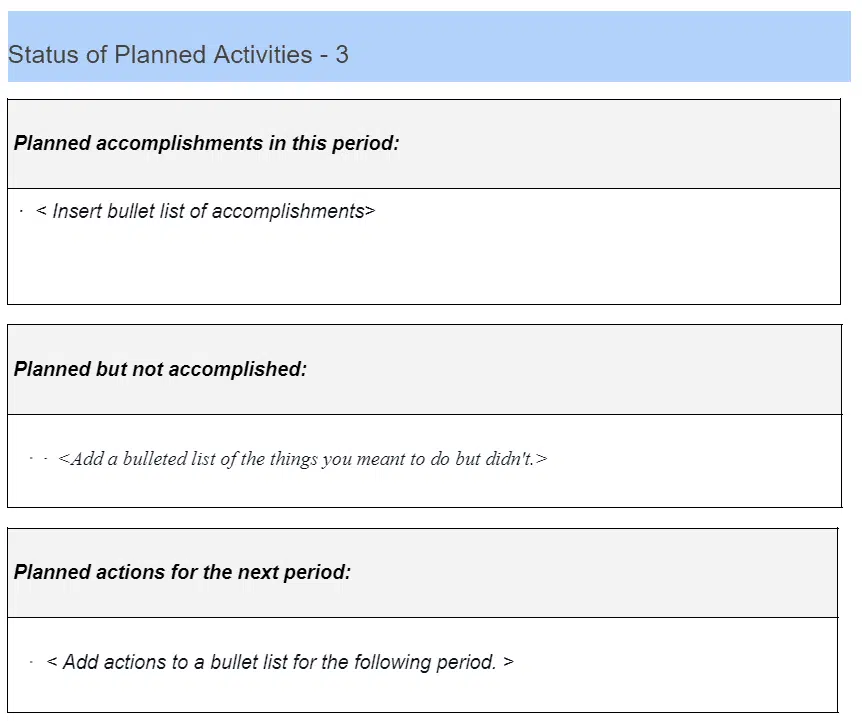
Conclusion
A project status report is a key project document and part of the performance report. These reports provide high-level information about the project’s status and quantify accomplished and upcoming activities in quantifiable terms.
Effective project status reports help project teams, and other stakeholders understand what is on track, where there are obstacles, what needs to be done next, and how the project is doing overall.

I am Mohammad Fahad Usmani, B.E. PMP, PMI-RMP. I have been blogging on project management topics since 2011. To date, thousands of professionals have passed the PMP exam using my resources.

